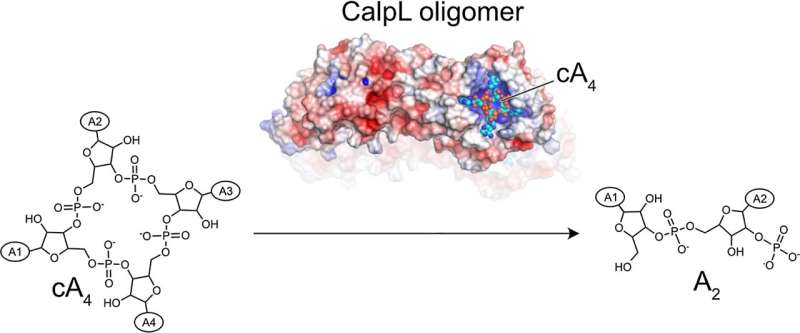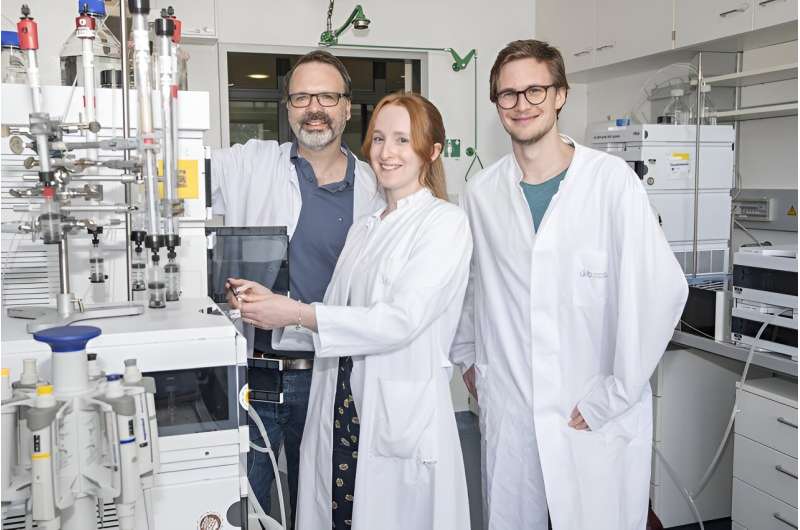This article has been reviewed according to Science X's editorial process and policies. Editors have highlighted the following attributes while ensuring the content's credibility:
fact-checked
peer-reviewed publication
trusted source
proofread
Researchers discover gene scissors that switch off with a built-in timer

CRISPR gene scissors, as new tools of molecular biology, have their origin in an ancient bacterial immune system. But once a virus attack has been successfully overcome, the cell has to recover.
Researchers from the University Hospital Bonn (UKB) and the University of Bonn, in cooperation with researchers from the Institut Pasteur in France, have discovered a timer integrated into the gene scissors that enables the gene scissors to switch themselves off. The results of the study have been published in the journal Nucleic Acids Research.
Some bacteria have developed CRISPR gene scissors in response to attacks by so-called phages. This bacterial immune system recognizes the phage genetic material, destroys it and thus protects against viral attacks.
When detecting phages, the type III variants of these immune systems produce messenger substances with cyclic oligoadenylates (cOAs), which the bacteria use to switch on a complex emergency plan. This ensures that a virus can be fought optimally and on a broad front.
The research team, led by PD Dr. Gregor Hagelueken from the Institute of Structural Biology at the UKB, who is a member of the Transdisciplinary Research Area (TRA) Life & Health and the Cluster of Excellence ImmunoSensation2 at the University of Bonn, discovered that the messenger substance cA4 produced by the gene scissors binds to a protein called CalpL. The protein scissors activated in this way trigger a signaling cascade that helps the cell to survive the viral attack.
The Bonn researchers had thus uncovered a completely new aspect of CRISPR systems, which can be easily reprogrammed for biotechnological and medical purposes. "These CRISPR-activated protein scissors that we discovered are a brand new tool in the toolbox of molecular biology," says Niels Schneberger, a doctoral student at the University of Bonn's Institute of Structural Biology at the UKB, who played a key role in the discovery of the CalpL protein.

Cellular recovery by limiting the antiviral response
"After a viral attack, however, it is crucial to eliminate the remaining cyclic oligoadenylates in order to terminate the antiviral reaction and return the cell to its normal state," says Sophie Binder, who shares the first authorship of the study with Schneberger and is also a doctoral student at the University of Bonn's Institute of Structural Biology at the UKB.
In cooperation with researchers from the Institut Pasteur in Paris and the Kekulé Institute for Organic Chemistry and Biochemistry at the University of Bonn, the Bonn researchers have now been able to show that the so-called SAVED domain of the CalpL protease has a ring nuclease activity that cleaves cA4.
"The protein therefore contains something like a molecular timer that switches off the immune reaction. By breaking down cA4 into linear fragments, the duration of the immune response is regulated, which enables a controlled return of the cell to normal conditions," says Binder.
A switchable protease such as CalpL is also of great interest for biotechnological applications. For example, it could be used as a molecular sensor. "The newly discovered ring nuclease activity is actually a disadvantage for such purposes," says PD Dr. Hagelueken. "However, in our study, we were also able to show how ring nuclease activity can be specifically inhibited so that the sensor does not switch itself off again."
More information: Sophie C Binder et al, The SAVED domain of the type III CRISPR protease CalpL is a ring nuclease, Nucleic Acids Research (2024). DOI: 10.1093/nar/gkae676
Journal information: Nucleic Acids Research
Provided by University Hospital Bonn

















